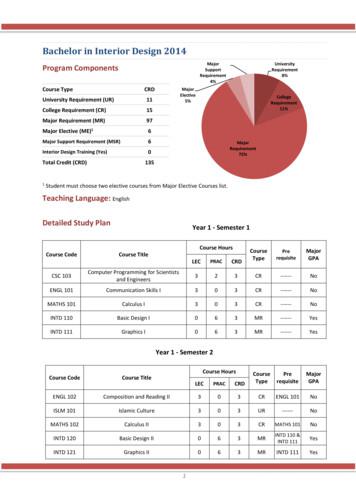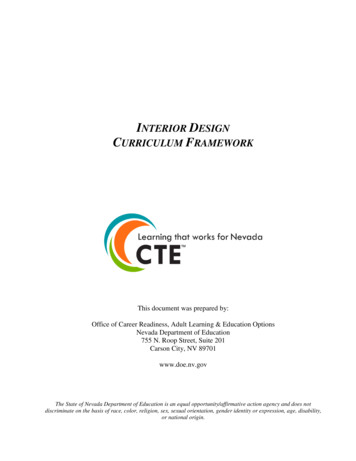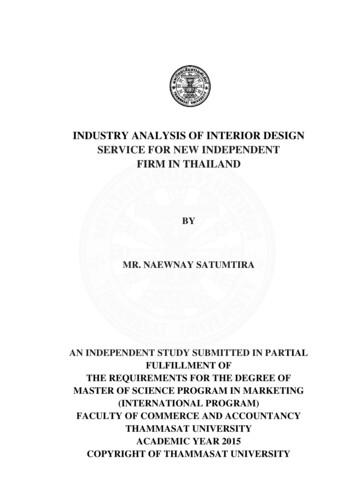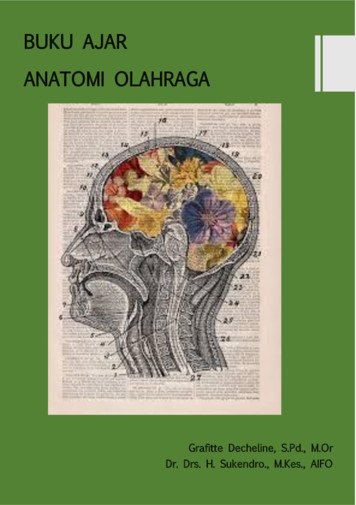Bachelor In Interior Design 2014
Bachelor in Interior Design 2014MajorSupportRequirement4%Program ComponentsCourse TypeCRDUniversity Requirement (UR)11College Requirement (CR)15Major Requirement (MR)97Major Elective (ME)1MajorElective5%CollegeRequirement11%6Major Support Requirement (MSR)6Interior Design Training (Yes)0Total Credit 5Student must choose two elective courses from Major Elective Courses list.Teaching Language: EnglishDetailed Study PlanYear 1 - Semester 1Course HoursCourse CodeCourse TitleLECPRACCRDCourseTypePrerequisiteMajorGPACSC 103Computer Programming for Scientistsand Engineers323CR------NoENGL 101Communication Skills I303CR------NoMATHS 101Calculus I303CR------NoINTD 110Basic Design I063MR------YesINTD 111Graphics I063MR------YesPrerequisiteMajorGPAYear 1 - Semester 2Course HoursCourse CodeLECPRACCRDCourseTypeCourse TitleENGL 102Composition and Reading II303CRENGL 101NoISLM 101Islamic Culture303UR------NoMATHS 102Calculus II303CRMATHS 101NoINTD 120Basic Design II063MRINTD 110 &INTD 111YesINTD 121Graphics II063MRINTD 111Yes1
Year 2 - Semester 3Course HoursLECPRACCRDCourseTypeInterior Design I084MRINTD 120 &INTD 121YesINTD 211History and Theory of Interiors I303MRINTD 120YesINTD 212Computer Aided Drafting143MRINTD 121YesINTD 213Presentation Techniques042MRINTD 120 &INTD 121YesINTD 216Color in Interiors122MRINTD 120YesPHYCS 107Physics for Building Design303MSR------NoCourse CodeCourse TitleINTD 210PrerequisiteMajorGPAYear 2 - Semester 4Course ior Design II084MRINTD 210 &ENGL 102YesINTD 221History and Theory of Interiors II303MRINTD 211YesINTD 222Materials and Methods of Construction I303MRINTD 121 &MATHS 101YesINTD 223Computer Aided Interior Design143MRINTD 212YesINTD 224Textiles303MRINTD 210YesHRLC 107Human Rights202UR------NoPrerequisiteMajorGPACourse CodeCourse TitleINTD 220Year 3 - Semester 5Course HoursLECPRACCRDCourseTypeInterior Design III084MRINTD 220YesINTD 311History of Islamic Interiors303MRINTD 221YesINTD 312Materials and Methods of Construction II303MRINTD 222YesINTD 313Environmental Control Systems I303MRINTD 220 &PHYCS 107YesINTD 314Computer Animations143MRINTD 223YesINTD 324Furniture Design122MRINTD 220YesCourse CodeCourse TitleINTD 3102
Year 3 - Semester 6Course HoursLECPRACCRDCourseTypeInterior Design IV084MRINTD 310YesINTD 322Working Drawings084MRINTD 223 &INTD 312YesINTD 323Environmental Control Systems II303MRINTD 313YesINTD 326Design, Culture, and Environment303MRINTD 310YesPSYC 103Introduction to rGPACourse CodeCourse TitleINTD 320PrerequisiteMajorGPATraining RequirementCourse HoursCourse CodeCourse TitleINTD 325Interior Design TrainingLECPRACCRD000MRCompletionTraining of 85 CreditsNoYear 4 - Semester 7Course ior Design V0105MRINTD 320YesINTD 411Graduation Project – Programming Stage303MRINTD 320YesINTD 413Management in Interior Design303MRINTD 320YesINTD 41XMajor Elective I from list 1XX3MEINTD 310YesINTD 424Interior Finishes303MRINTD 312YesPrerequisiteMajorGPACourse CodeCourse TitleINTD 410Year 4 - Semester 8Course HoursCourse CodeLECPRACCRDCourseTypeCourse TitleINTD 420Graduation Project – Design Stage0126MRINTD 410 &INTD 411YesINTD 422Professional Practice and Documentation303MR------YesHIST 122Modern History of Bahrain and Citizenship303UR------NoARAB 110Arabic Language Skills303UR------NoINTD 42XMajor Elective II from list 2XX3ME------Yes3
Major Elective Coures11Student must choose two elective courses from Major Elective Courses list.Course CodeCourse HoursCourse TitleLECPRACCRDCourseTypePrerequisiteMajorGPAList 1INTD 414Social and Cultural Factors in Design303MEINTD 310YesINTD 415Interior Planting and Courtyard Design303MEINTD 310YesINTD 416Architectural Design223MEINTD 310YesList 2INTD 425Islamic Ornamentation303MEINTD 320YesINTD 427Special Topics in Interior Design223MEINTD 320Yes4
Course DescriptionCourse Code:INTD 110Course Title:Basic Design IRole of design basics in interior design context. Design elements: point, line, shape, form, space, color, texture, andlight. Design principles: proportion, harmony, rhythm, emphasis, dominance, focal point, balance, and unity. Spatialrelationships: space within a space, adjacent spaces, interlocking spaces, spaces linked by a common space. Types ofdesign organizations: centralized, linear, clustered, radial, and grid. Two and three dimensional design problemsemphasizing creative thinking and processing the given information.Course Code:INTD 111Course Title:Graphics IUse of drafting tools and equipment, graphic symbols and lettering, drawing fundamentals, projection systems,orthographic projection, axonometric and isometric projections, application of projection techniques for theproduction of architectural drawing (plans, sections, elevations), dimensioning, sketching.Course Code:INTD 120Course Title:Design Basics IIColor systems (color wheels). Properties of color, color principles. Texture: tactile and visual. Visual perception ofcolors and textures. Relationships and differences between abstract and functional design. Functional definition of aspace: identifying users' activities and requirements. Movement through space and /or space groups. Spacerequirements for activities, circulation, furniture and equipment. Functional relationships among activity areasand/or spaces. Two and three dimensional design alternatives for simple interiors and space groups. Emphasisplaced on creativity, conceptual thinking and implementation of given information in both design basics courses.Course Code:INTD 121Course Title:GraphicsPrinciples of perspective drawing, representation of interiors with the aid of manual perspective drawing techniques(one and two points perspectives), shade and shadows in plans, elevations, and perspectives, conceptual drawings.Course Code:INTD 210Course Title:Interior Design IInterior design of a simple space. Introduction to programming; functional analysis, anthropometrical and ergonomicrequirements, area requirements, circulation requirements and furniture arrangement, treatment of interiorsurfaces.Course Code:INTD 213Course Title:Presentation TechniquesFocus on oral and visual presentation skills needed in the interior Architecture profession. Exploration of basicrendering techniques for different materials in floor plans, elevations, and perspectives. Color rendering of handdrawn and digital images.Course Code:INTD 212Course Title:Computer Aided DraftingIntroductory course in computer aided drafting. Use of AutoCAD software effectively to create computer-generatedfloor plans, elevations, and details that meet current professional standards. Use of Photoshop software torepresent complete 2D CAD drawings with appropriate materials and renderingCourse Code:INTD 211Course Title:History and Theory of Interiors ISurvey of interiors from pre-history cave settlements until the European Renaissance; emphasis is placed on therelationship between the social, economic, political, and environmental factors, and the formation of architecture,interior spaces, interior surfaces, furniture, and ornamentation.Course Code:INTD 216Course Title:Color in InteriorUse of color in interiors. Emphasis on color theory, psychology of color and its effects on moods. Application of colorin interior environments with lighting conditions.Course Code:INTD 220Course Title:Interior Design IIDesign principles, organization and spatial relationship patterns. Analysis of the structure (load bearing system) ofgiven building. Study of function, ergonomics and circulation. Development of design criteria and design concept.Functional relationships among spaces, and spatial planning. Color applications. Medium size projects of mediumcomplexity of commercial facilities.5
Course Code:INTD 221Course Title:History and Theory of Interiors IISurvey of interiors from Baroque period to present; emphasis is placed on the relationship between the social,economic, political, and environmental factors, and the formation of architecture, interior spaces, interior surfaces,furniture, and ornamentation; presentation of theoretical discourse during the Nineteenth and Twentieth Centuries,leading to contemporary interiors design directions.Course Code:INTD 222Course Title:Materials and Methods of Construction IIntroduction to structures as building sub-systems. Structural loads, basic states of structural stresses and forces.Structural systems and components: framed systems (columns, beams, slabs, and footings), bearing walls systems(walls, slabs, strip foundation), trussed systems, space frames, geodesic domes, arches, vaults, tents, pneumaticsystems, shells and folded plates. Structural materials (reinforced concrete, metals, brick, concrete blocks, stone,and timber).Course Code:INTD 223Course Title:Computer Aided Interior DesignContinuation of INTA 212 with emphasis on three dimensional AutoCAD drawing and modeling techniques. 3D Maxvisualization software. Use of the software to think in three dimensions, creation of 3D objects, standard draftingversus 3D techniques. Presentation of interiors as picture images and design prints enhanced by advancedPhotoshop rendering and lighting techniques.Course Code:INTD 224Course Title:TextilesClassification of textiles according to origin of their basic materials (natural fibers, manmade fibers, yarns, etc.).Fabric structure, fabric design (motifs, textures, layout, color application), fabric selection criteria and application fordifferent uses. Specifications, and purchase order writing.Course Code:INTD 310Course Title:Interior Design IIIDesign Project focus on: Analysis of the structure of given building. Programming. Development of design conceptand criteria. Selection of interior finishes, textiles, furniture and styles. Furniture arrangements and interior surfacetreatments. Projects of medium size with medium complexity for hospitality and educational facilities.Course Code:INTD 311Course Title:History of Islamic InteriorsSurvey of Islamic interiors including examples from Umayyad, Abbasid, Moorish, Mogul, and Ottoman periods;emphasis on mosque and residential architectural types; Islamic ornamentation and calligraphy; influence of culturaland religious factors on Islamic interiors.Course Code:INTD 312Course Title:Materials and Methods of Construction IIIntroduction to non-structural building sub-systems. Types of non-structural walls and partitions, windows, doors,stairs, ramps, and suspended ceilings. Related building materials (brick, concrete blocks, reinforced concrete, timber,metal, and plastic).Course Code:INTD 314Course Title:Computer AnimationsIntroduction to digital animation. Concepts, theory, and aesthetics of digital design and animation, creating 2Delements and 3D models, applying surface materials, lighting, animation and rendering scenes. Video editingsoftware (eg. Adobe Premier or Windows Movie Maker) may be used.Course Code:INTD 313Course Title:Environmental Control Systems IClassification of environmental control systems. Passive climate control: thermal comfort conditions, heat transferthrough walls and floors, selection of interior surface finishes in accordance with heat control, orientation of roomswith regard to solar radiation and wind control, air quality and natural ventilation. HVAC systems: their function,components, and system layouts. Illumination systems: visual comfort, day lighting, artificial lighting: light sources,lighting fixtures, lighting systems, lighting systems design and selection of interior finishes in accordance withrequired light reflectance. Integrated lighting.Course Code:INTD 324Course Title:Furniture DesignEmphasis on innovation and creativity in the design of functional and aesthetically pleasing pieces of furniture.Appropriate materials and forms for the construction of custom furniture for specific uses. Detailing of customfurniture considering sustainable alternatives.6
Course Code:INTD 325Course Title:Interior Design TrainingEach student must participate in training program in the relevant industry where he is expected to gain practicalexperience.Course Code:INTD 320Course Title:Interior Design IVEmphasis on technical issues such as structures (strength and stability), characteristics of finishes, lighting and airconditioning systems. With regard to functional and aesthetical satisfaction, integration of the layouts of airdiffusers, absorbers and lighting fixtures with furniture arrangement, floor and wall patterns and treatments.Projects of large scale with high level complexity for corporate and institutional facilities.Course Code:INTD 322Course Title:Working DrawingsProduction of working drawing set for small projects. Detailing: connections of external wall and floor, connectionsof external wall and roofs, windows, external and internal doors, stairs, cabinetry. Structural plan and sections.Furniture, fixture and equipment organization plans and sections. Floor and wall tiling plan and elevations. Electrical,HVAC and plumbing layouts. Reflected ceiling plan (integration of lighting fixtures, air diffusers and absorbers,smoke sensors and sprinklers).Course Code:INTD 323Course Title:Environmental Control Systems IIRoom acoustics, aural comfort, reverberation time and good hearing criteria for rooms of special purposes. Noisecontrol. Selection of finishes in accordance with sound absorption and required reverberation time. Fire control.Passive fire control: escape routes, fire exits, compartmentation. Firefighting systems and equipment. Sanitaryinstallations.Course Code:INTD 326Course Title:Design, Culture and EnvironmentExamination of the interrelationship among culture, environment, and design; issues of sustainability, globalization,identity, culture, and human behavior are addressed as forces in the formation of contemporary interiors; issues arediscussed at both local and international scales.Course Code:INTD 410Course Title:Interior Design VComprehensive design with emphasis on socio-cultural and technical issues such as build-ability, sustainability,acoustics, noise control, firefighting and plumbing systems. Projects of large scale with high level complexity forHospitality, Socio Cultural and Health care facilities.Course Code:INTD 411Course Title:Graduation Project- Programming StagePreparation of graduation project report to include the identification of graduation project, selection of interiorspaces for the project, theoretical studies related to the topic of the project, analysis of users' characteristics andneeds, development of project's program and functional relationships, identifying conceptual directions for thedesign, discussion of spatial qualities, color schemes, furniture, materials, and surface treatments appropriate forthe project.Course Code:INTD 413Course Title:Management in Interior DesignPlanning, organizing and control of interior Architecture projects. Methods of task break-down, scheduling, costanalysis and cost estimation. Writing specifications. Types of bidding and preparation of bid documents. Facilitymanagement concerns in interior Architecture.Course Code:INTD 424Course Title:Interior FinishesCriteria for selection of finishes (durability, fire resistance, humidity resistance, heat storage, easy cleaning andmaintenance, sound absorption and noise control, light reflection, prevention of air pollutants and mites). Wallfinishes (brick and stone veneer, precast concrete, gypsum boards, ceramics, GRC, metals, wood, glass, plaster,paint), floor finishes (stone, ceramics, plastic tiling, wood parquet, terrazzo, carpeting), ceiling (plasters, paint, wood,suspended ceiling materials).Course Code:INTD 420Course Title:Graduation Project II (Design Stage)A comprehensive Interior Design project based on the design program developed in the Programming Stage; projectpresents a synthesis of information acquired during previous semesters; and an opportunity to exhibit student'sabilities as a designer and his/her personal ideology and beliefs in relation to interior Architecture.7
Course Code:INTD 422Course Title:Professional Practice and DocumentationBasic principles, procedures of office systems of interior Architecture, types of professional practices, contracts andletters of agreement, responsibilities, professional ethics, portfolio review and development.Electives:Course Code: INTD 414Course Title:Social and Cultural Factors in DesignThis course is an overview of significant social, cultural and human behavioral factors related to space. Major designproblems and the influences of sociocultural issues are analysed in relation to space layout of the buildings. Reading,discussions,films, and empirical case studies/ assignments will focus on understanding different arrangements ofspaces that influence social and cultural behaviors of the built environment.Course Code:INTD 415Course Title:Interior Planting and Courtyard DesignBasic principles of garden and courtyard design. Functional, formal, and visual aspects of small open spaces. Interiorplanting (types, uses, care), composing with plant materials.Course Code:INTD 416Course Title:Architectural DesignDefinition of Architectural Design. Steps in Architectural Design. Similarities and differences between designprocesses in Interior Architecture and Architecture. A small size Architectural design project.Course Code:INTD 425Course Title:Islamic OrnamentationDefinition and materials of ornamentation. Methods of ornamentation: carving, chiseling, embossing, engraving,painting, gilding, inlaying, marquetry, tapestry and cladding with mosaic, ceramic, brick, gypsum etc. Elements ofIslamic ornamentation, motifs and patterns. Classification of motifs and patterns: Vegetal and floral patterns,geometric patterns, figural patterns, calligraphy. Exercises in developing different motifs and patterns.Course Code:INTD 427Course Title:Special Topics in Interior DesignFlexible course in terms of topics in accordance with interests of faculty and students. Structured individually byinstructors to provide special opportunities to explore specific topics in interior Architecture. Course topic subject toProgram Council approval.LIBERAL ARTS COURSESCourse Code:PHYCS 107Course Title:Physics for Building DesignFundamentals of heat transfer through building envelope: Air to air heat transmittance (U), internal and externalsurface conductance (h), thermal conductivities of building materials (k). Relationships between interior finishingmaterials and (U) values.Nature of light, light transmission, reflection and absorption. Basic properties of light (photometric quantities): Lightintensity (I), luminous flux (lx), illumination level (E), luminance (L). Photometric laws: Abney’s law, inverse squarelaw, cosine law.Nature of sound: Audible sounds. Sound quantities: Sound intensity level (I) and sound pressure level (p).Soundreflection and absorption in enclosed spaces. Reverberant sound and reverberation time (RT). Sound transmissionsthrough partitions and building envelope. Sound reduction index.Course Code:PSYC 103Course Title:Introduction to PsychologyPrinciples and basic understanding in different psychology fields: behavior biological foundation, growth principles,education, motivation, reactions, comprehension, character, social aspects of behavior, tension and psychologicalhealth.8
College Requirement Courses DescriptionsCourse Code: CSC 103Course Title: Computer Programming for Scientists and EngineersIntroduction to computers, their uses, development, components, hardware, and software. Internal representationand numbering systems. Algorithmic problem solving principles. Introduction to a modern programming language(e.g. C ). Input/Output, conditional statements, iteration, files, strings, functions and arrays. Lab assignments topractice programming.Course Code: ENGL 101Course Title: Communication Skills IThis course focuses on reading skills and strategies and language development. The reading section concentrates onhigh-interest contemporary topics and encourages students to increase speed and efficiency. The writingcomponent, integrated to the reading materials, reviews grammatical structures, develops language accuracy andintroduces paragraph writing. Students are required to upgrade their grammar, reading, and listening skills on theinternet.Course Code: ENGL 102Course Title: Composition and Reading IIA continuation of English 101 which further develops the students' skills in reading and writing. The course exposesstudents to wider range of reading material aimed at developing their understanding of different styles of English.Course Code: MATHS 101Course Title: Calculus IAlgebra. Functions and graphs. Trigonometry. Conic sections. Limits and continuity. Derivatives and integrals.Applications of derivatives which include mean value theorem, extrema of functions and optimization. Definiteintegrals and the Fundamental Theorem of Calculus.Course Code: MATHS 102Course Title: Calculus IIApplications of definite integrals, including areas, volumes and surface areas of solids of revolution, arc length andcentroids. Transcendental functions, indeterminate form and L’Hopital’s Rule. Techniques of integration andimproper integrals. Infinite series, power series. Maclaurin and Taylor Theorem.9
University Requirements Courses DescriptionsCourse Code: ARAB 110Course Title: Arabic Language SkillsThis course focuses on basic Arabic skills including form, function, and meaning. It also helps the student toappreciate and understand structures and approach them from a critical point of view, through various genres inliterature.Course Code: HIST 122Course Title: Modern History of Bahrain and CitizenshipSpatial identity of Bahrain: Brief history of Bahrain until the 18th century; the historical roots of the formation of thenational identity of Bahrain since the 18th century; the modern state and evolution of constitutional life in Bahrain;the Arabic and Islamic dimensions of the identity of Bahrain; the core values of Bahrain’s society and citizenshiprights (legal, political, civil and economic); duties; responsibilities and community participation; economic changeand development in Bahrain; Bahrain’s Gulf, Arab and international relations.Course Code: HRLC 107Course Title: Human RightsThis course deals with the principles of human rights in terms of the definition of human rights, scope, sources witha focus on the International Bill of Human Rights; The Charter of the United Nations; Universal Declaration of HumanRights; The International Covenant on Economics, Social and Culture rights; Convention against Torture and otherCruel, Inhuman or Degrading Treatment or Punishment; Mechanics and the Constitutional Protection of Rights andPublic Freedoms in Kingdom of Bahrain.Course Code: ISLM 101Course Title: Islamic CultureAn introduction to the general outline and principles of Islamic culture, its general characteristics, its relationshipswith other cultures, general principles of Islam in beliefs, worship, legislation and ethics.10
interior spaces, interior surfaces, furniture, and ornamentation. Course Code: INTD 216 Course Title: Color in Interior Use of color in interiors. Emphasis on color theory, psychology of color and its effects on moods. Application of color in interior environments with lighting conditions. Course Code: INTD 220 Course Title: Interior Design II
Bachelor of Science 2020/2021 www.usm.my SCHOOL OF PHARMACEUTICAL SCIENCES Bachelor of Pharmacy COMMUNICATIONS Bachelor of COMMUNICATIONS SCHOOL OF MANAGEMENT Bachelor of ACCOUNTING Bachelor of MANAGEMENT BACHELOR OF APPLIED SCIENCE SCHOOL OF PURE SCIENCES (PHYSICS, BIOLOGY, CHEMISTRY AND MATHEMATICS) BACHELOR OF SCIENCE SCHOOL OF MECHANICAL .
Interior Design I L1 Foundations of Design* L1 Interior Design II L2 Interior Design II LAB* L2L Interior Design III L3C Interior Design III LAB* L3L Interior Design Advanced Studies * AS *Complementary Courses S TATE S KILL S TANDARDS The state skill standards are designed to clearly state what the student should know and be able to do upon
is a need for interior design textbooks to reflect this context and allow interior design students to keep pace with rapid development of the industry. This series of interior design textbooks is aimed at satisfying the needs of Hong Kong interior design students at different academic levels from diploma, higher diploma to bachelor's degree .
What is Interior Design? Interior Design is a "unique blend of art and science. Interior decorating is the embellishment of interior finishes and the selection and arrangement of fabrics and furnishings" according to Beginnings of Interior Environment by Phyllis Sloan Allen, Lynn M. Jones and Miriam F. Stimpson. Interior designers are trained .
Figure 6: 3 sub-segments of interior design firm’s client. 17 Figure 7: Customer segment of interior design market 19 Figure 8: Logo of TIDA (Thailand Interior Designer association) 20 Figure 9: Design process 21 Figure 10: Schematic design 22 Figure 11: Interior turnkey scope of
Aug 27, 2006 · The Interior Design Manual (IDM) will provide VA staff participating in the development of interior design projects with an understanding of their roles, responsibilities and the appropriate procedures for creating a comprehensive Interior Design environment. All VA staff members taking part in interior design are expected to follow this manual
INTERIOR DESIGN & BUILD ISLE OF WIGHT joisleofwight@yahoo.com 07964829997 www.coastiow.co.uk COAST IOW LTD INTERIOR DESIGN & BUILD Curabitur leo. COAST IOW LTD INTERIOR DESIGN & BUILD . Coast IOW Ltd - Interior Design Portfolio Created Date: 6/8/2021 8:14:52 AM .
Anatomi Olahraga 6 Fisiologi Sistem Tulang 52 Sel Penyusun Tulang 53 BAGIAN IV ARTHROLOGI 64 Klasifikasi Sendi 64 A. Berdasrkan Tanda Struktural Yang Spesifik 64 B. Berdasrkan Jumlah Aksisnya 71 C. Berdasarkan Bentuk Permukaan Tulang 72 D. Berdasarkan Komponen Penyusun Kerangka 74 E. Berdasarkan Luas Gerakan 74 BAGIAN V MIOLOGY 76 Fibra Otot Seran Lintang 79 Fibra Otot Polos 84 Fibra Otot .























